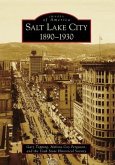For the residents of the Naugatuck Valley, in the days before shopping malls and highways, downtown Waterbury was the place to go. The clock tower, the horse fountain, the Palace Theater, the curved building on Grand and Meadow Streets, abandoned mills, buried rivers, railroads to nowhere-these are some of the familiar and not-so-familiar landmarks of Waterbury. Who built them and why? Waterbury: 1890-1930 is a step back to a time when Waterbury was a major industrial center. Expanding factories were at peak production, churning out enormous quantities of brass products, and the city was struggling to keep pace with its own population explosion.
Hinweis: Dieser Artikel kann nur an eine deutsche Lieferadresse ausgeliefert werden.
Hinweis: Dieser Artikel kann nur an eine deutsche Lieferadresse ausgeliefert werden.








